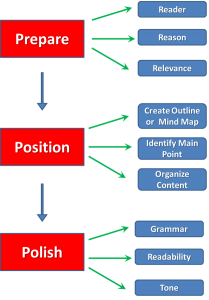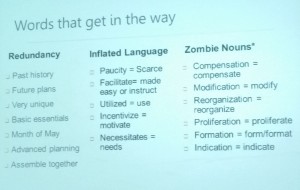By: Itzamarie Chevere-Torres
“Good writing is good writing; it doesn’t matter if it is an email” Danielle Heuer, co-founder of Every Voice Educates and Communication Consultant and Coach for WD Communications, said as she started the presentation on Science Business Writing Workshop.
The key to effective writing is to know your reader and to write just the necessary information using short sentences and everyday words. Remember to bring your most important idea to the beginning of your document, the lead. For scientists, this is a big challenge. We are trained to think that to make our ideas valid we have to justify them with as much background as possible. As a result, our most important ideas get lost in a sea of long sentences and complicated jargon.
Danielle shared with us three tips on how to shift our writing strategy and style to be more efficient communicators in the workplace: Prepare, Position, and Polish.
 Prepare: Think about your readers before you start writing. Who are your readers and what is their background knowledge? Are they subject experts? Are they scientists or business professionals? What is the preferred style of the reader? By answering these questions, you will motivate a positive reader response. Next, identify your reason for writing. What action do you want the reader to take? Think of action verbs and imagine the goal you want to accomplish with your writing. If you are sending an email asking for the progress of a task, make sure to state what the reader needs to do clearly. Most likely you will be communicating with people who have no time for reading long messages. You have to convey your message and give them the necessary information to act. Which brings me to the last point, relevance. What content must you include to achieve your reason for writing? How much content is necessary? In establishing relevance, context is more important than background information. In other words, why does the reader need that information? In business environments, people care about results and their meaning in relation to their business. This is why is important to use short sentences to make your main point.
Prepare: Think about your readers before you start writing. Who are your readers and what is their background knowledge? Are they subject experts? Are they scientists or business professionals? What is the preferred style of the reader? By answering these questions, you will motivate a positive reader response. Next, identify your reason for writing. What action do you want the reader to take? Think of action verbs and imagine the goal you want to accomplish with your writing. If you are sending an email asking for the progress of a task, make sure to state what the reader needs to do clearly. Most likely you will be communicating with people who have no time for reading long messages. You have to convey your message and give them the necessary information to act. Which brings me to the last point, relevance. What content must you include to achieve your reason for writing? How much content is necessary? In establishing relevance, context is more important than background information. In other words, why does the reader need that information? In business environments, people care about results and their meaning in relation to their business. This is why is important to use short sentences to make your main point.
Position: There are different techniques to organize your ideas before writing. For example, you can create a list or an outline for your main idea and various subtopics. You can even use handwritten notes if that works for you. The importance is that you find the technique that works and helps to get the information out of your brain and into the paper. For the more visually inclined, Danielle talked about a strategy called mind maps. Similar to brainstorming on a white board, mind mapping is a diagram used to organize your ideas visually. By placing your main idea in the center, you can branch out other ideas. It forces you to find relationships and hierarchy among the different ideas.
There is different free software for mind mapping, but you could easily create one on Power Point. Once you have a writing plan on paper, it’s a matter of, positioning your main point strategically and organizing the rest of the content in a logical way.
Polish: “Never use two words when you can use one”—Danielle Heuer. To ensure that readers understand your writing and message, make sure to revise your grammar and cut the clutter. Avoid redundancy and nouns turned into verbs, something that Danielle called, zombie nouns. If necessary, step away from your document and revisit it later to make the necessary changes. Another way of improving your writing is to consider the readability of your text. Try to have sentences with no more than 15 to 20 words. Like Elmore Leonard—short story writer and screenwriter— said about writing, “I try to leave out the parts readers skip.” If you are writing an email or a mobile-enabled document, keep the length of your sentences to seven or eight words. By keeping the sentence length short enough, it will maintain the reader’s engagement. The beginning of each section or paragraph grabs the attention of the reader when first sentences are shorter. Another piece of advice from Danielle, instead of having a long sentence with three ideas, is better to have three short and concise sentences, one for each idea.
Another way of improving your writing is to consider the readability of your text. Try to have sentences with no more than 15 to 20 words. Like Elmore Leonard—short story writer and screenwriter— said about writing, “I try to leave out the parts readers skip.” If you are writing an email or a mobile-enabled document, keep the length of your sentences to seven or eight words. By keeping the sentence length short enough, it will maintain the reader’s engagement. The beginning of each section or paragraph grabs the attention of the reader when first sentences are shorter. Another piece of advice from Danielle, instead of having a long sentence with three ideas, is better to have three short and concise sentences, one for each idea.
Readability statistics are a measurement on how easily a person can read and understand the text in a document. They can predict the level of difficulty of reading a particular document. There are tools to measure the readability with scores based on the number of passive sentences in the text, ease of reading, and grade school level. You can find these scores using the proofing tool on Microsoft Word. When writing, aim for less than thirty-five percent passive sentences. On a reading ease scale, from zero to hundred, the score should be thirty or higher. The higher the score, the easier is to understand the document. Regarding grade school level, a score between eight and ten should be good enough, depending on who your readers are. A grade level of eight means that an 8th grader can easily understand your writing.
Before sending that email or document, check for appropriate tone. An inappropriate tone can cause miscommunication or wrong assumptions. If you have to answer or send an email, never react while writing. It is better to walk away until you have a clear mind. Always include a greeting and closing remark. Avoid sending negative feedback on emails or using negative words like, no, never, unfortunately, or cannot. Conversations that will require these words are likely better addressed in person.
In any line of work, whether we stay in academia or move on to other careers, we have to communicate with others in a professional, clear and succinct way. Whether we choose to or not, we will always end up communicating, writing and preparing different sorts of documents. Since we live in a digital era where face to face communication has been replaced with emails and social media platforms, we are mostly known by what or how we write. We are then responsible for conveying the right message and right image. The way we communicate in our workplace can either enhance or destroy our professional image. In the end, you want your reader to be happy which can make all the difference for your professional reputation.
